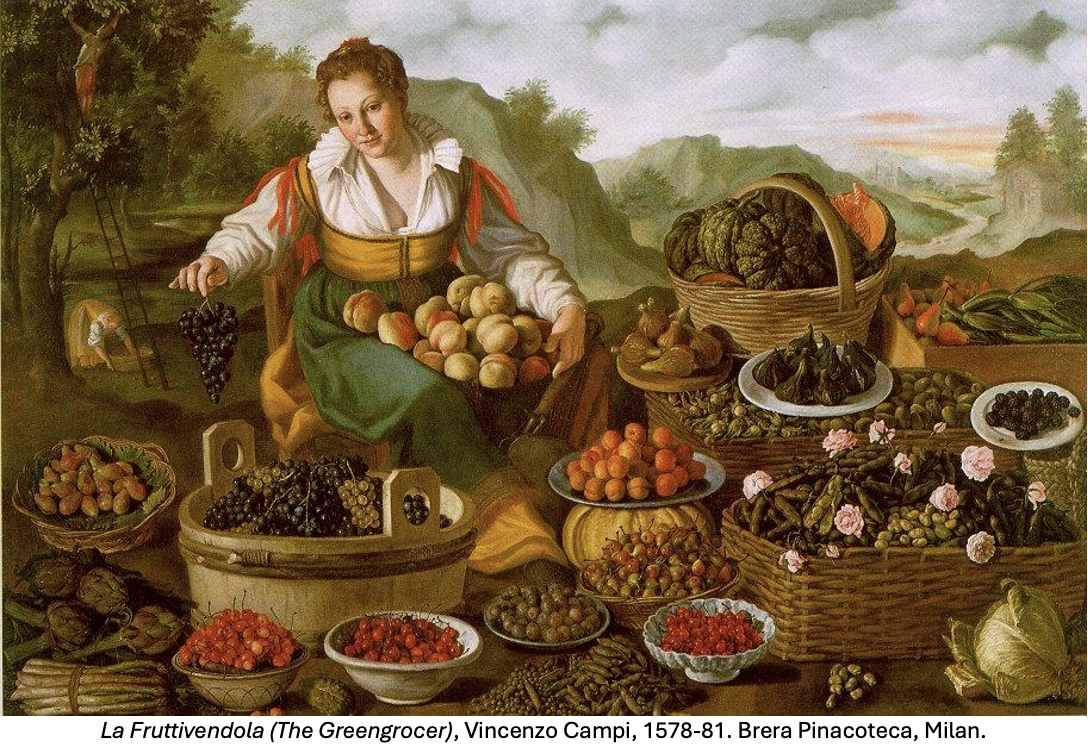
DINING IN THE RENAISSANCE:
From Garden to Table
The Renaissance (circa 1400-1600) was one of those magical periods in world history in which the right conditions led to a wave of creativity in all the arts. What began in the 14th century Italian city-states as a desire of scholars to study, celebrate and integrate the great culture of their ancient predecessors soon spread throughout Europe and launched a movement that came to be seen as not just a re-birth of earlier ideals but the dawn of a new, modern era.
The burgeoning university system, along with the invention of the printing press making books more affordable and available, brought scholarly study beyond the realm of clergy and nobility to a larger community of knowledge-seekers. Ancient Greek and Latin texts were read and discussed, with philosophy, science and politics seen afresh in light of this new respect for the past. Humanism was among the concepts being revived, seeing man as “the measure of all things,” capable of solving problems and acquiring knowledge through study and observation of nature as opposed to relying solely upon divine revelation and the mercy of God. Meanwhile, Roman-era architectural ruins, sculpture and frescoes of astonishing beauty were being unearthed as building commenced to revive and modernize the Eternal City, providing inspiration to artists and patrons alike. Eventually this “re-birth” in appreciation for antiquity spilled over into the visual arts where a return to the ancient aesthetic of naturalism and balance became the outward expression of the Renaissance mindset.
Among the many art forms to undergo such a transformation was architecture and, along with it, garden design. The Renaissance garden was designed to be a place of beauty and repose that would promote physical health and intellectual alertness by repeating the symmetry, harmony and symbolism of the ancient Roman garden. The enclosed space of the medieval garden now gave way to an open view that was meant to integrate the garden and landscape beyond as if it were of a single design. It was an important extension of the suburban villa, a refuge for the upper class from busy city life that had been so prevalent in ancient times and that was enjoying renewed popularity outside Rome, Florence and Venice.
Gardens were planted with decorative, medicinal, botanical and culinary purposes in mind. There was most certainly a kitchen garden in each of these villas, and areas where a meal could be graciously offered and enjoyed al fresco. Studies of botanical, pharmaceutical and medical writings underscored the importance of diet to a person’s well-being, so the culinary arts were suddenly deemed worthy of examination and re-interpretation. A revolution in this regard was already underway on the Italian peninsula, where a preference was noted towards simply prepared dishes of a large variety of local, fresh ingredients over the heavily spiced, complex concoctions and meat-centric diet popular elsewhere in Europe. This lighter fare was evident in early Renaissance cookbooks from Italy, where local chefs were emerging as Europe’s culinary leaders. Pasta dishes began to appear among these recipes, providing a hint at where the Italian diet was headed.
Renaissance visionaries were keen to elevate culinary pursuits as an art form, and they considered creativity in combining ingredients in a healthy and flavorful way to be of utmost importance. In comparing themselves to their ancient predecessors, they were convinced that their cuisine was superior to that of the Greeks and Romans.
Our foray into Renaissance cuisine will be to recreate a leisurely meal similar to one that may have been enjoyed centuries ago in a garden setting. Inspired by some of the images of Renaissance gardens that come down to us today in paintings and illuminations, and following recipes suggested by the great chefs of the time, we will allow our senses to engage in an imaginary return to the pleasures of the Renaissance.
